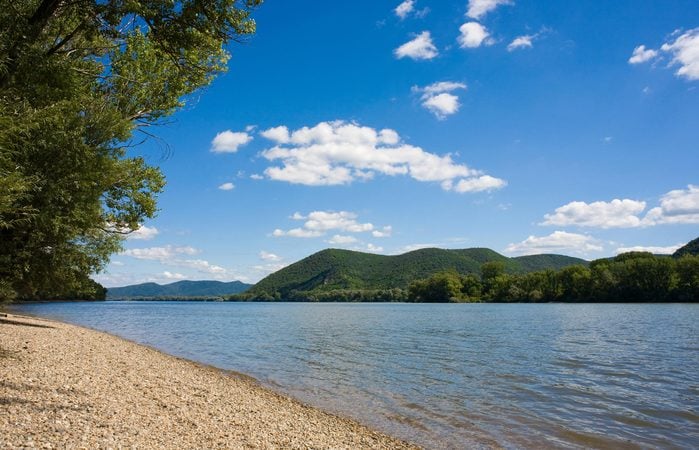
River Danube (then)
The Danube is Europe’s second-longest river, flowing 1,770 miles through ten countries from Germany, where it originates, to Romania, where it drains into the Black Sea. “Since the beginning of historical time,” says Smithsonian Magazine, “traders and migrants, mercenaries and adventurers have followed the Danube into the heart of the continent, carrying goods, ideas, and innovations.” Locals in places like Vienna have long used various beaches along the Danube as access to the river for swimming. The Danube has also long been popular for river cruises.
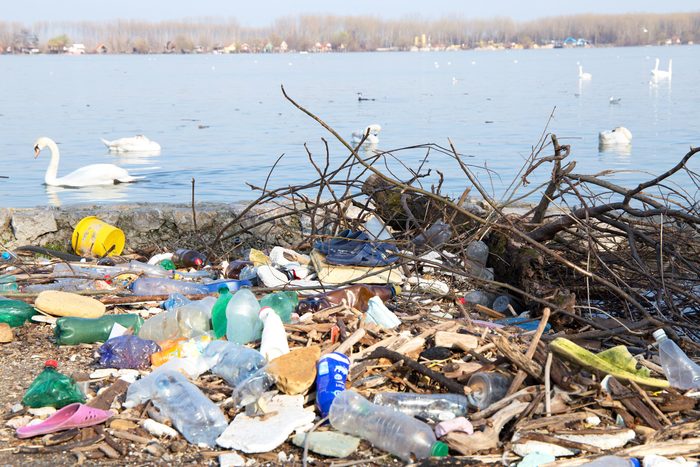
River Danube (now)
These days, the Danube has fallen prey to the scourge of pretty much every waterway the globe over: plastics pollution (with a little pesticide run-off and pharmaceutical waste thrown in for good measure, according to The Guardian). Plastic trash from a variety of industries is finding its way into this important waterway, necessitating coordinated efforts to clean it up—and keep it that way—from the ten countries the river flows through. So far, that’s been an uphill battle, although individually, countries like Romania and Austria are seeking their own solutions. These beaches have the clearest water in the world.
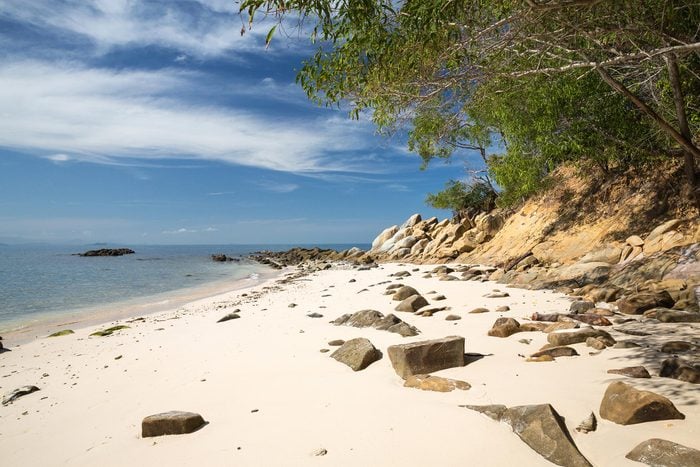
Kota Kinabalu beaches, Malaysia (then)
The beaches near the Malaysian capital have been hailed by guidebooks as veritable paradises on Earth—with blinding white sands bordering warm tropical waters, fringed all around with palm trees filled with beautiful birds and animals. Coral reefs beckon snorkelers, supposedly pristine national forest provides a lush backdrop, and every day is capped by a sunset of astonishing beauty.
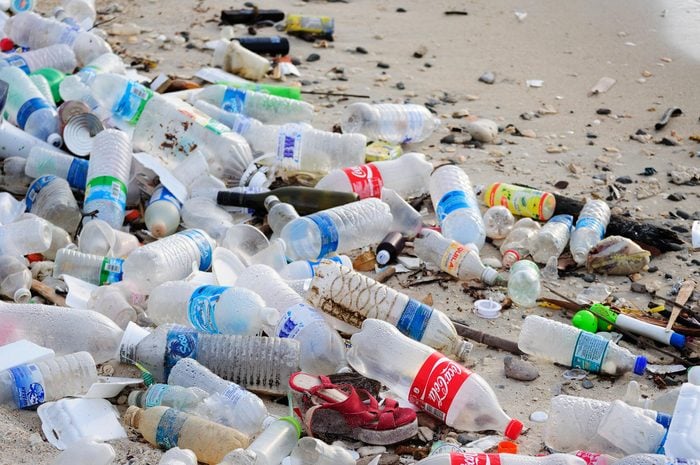
Kota Kinabalu beaches, Malaysia (now)
In the past few years, though, the Kota Kinabalu beaches have been overrun with trash—causing the city’s mayor to call upon citizens to do their individual “duty to take care of the environment by at least picking up rubbish in front of them,” according to New Straits Times. Although the mayor blamed litterbugs for the extreme pollution of local beaches—over 440 pounds of trash were picked up from about a third of a mile of beach in one day in 2016—the true cause of Malaysia’s dirty ocean woes are the same as everyone’s: marine debris, either purposefully (illegally) dumped or blown in by accident, is contributing to increasingly filthy shorelines.
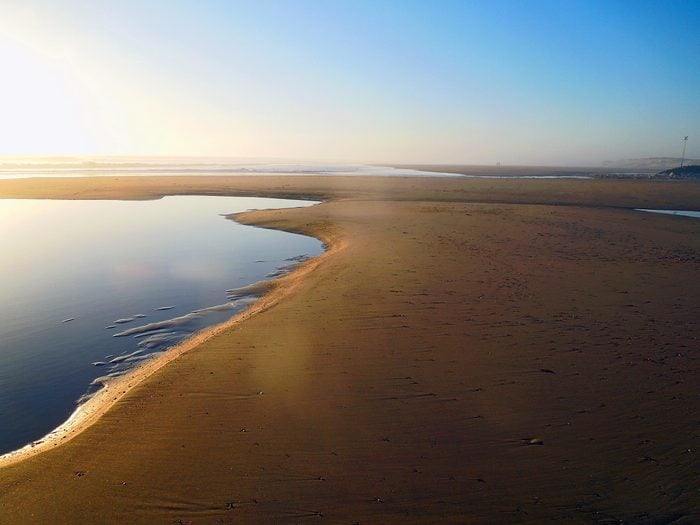
Montalivet, France (then)
The town that’s officially called Venday-Montalivet, on Southwestern France’s Atlantic coast, boasts 5 miles of beach backed by pine forest—and was first discovered as a coastal resort in the mid-19th century. Popular with surfers and nudists (yes, that’s a thing all over France), this beach once won the prestigious Blue Flag award for cleanliness.
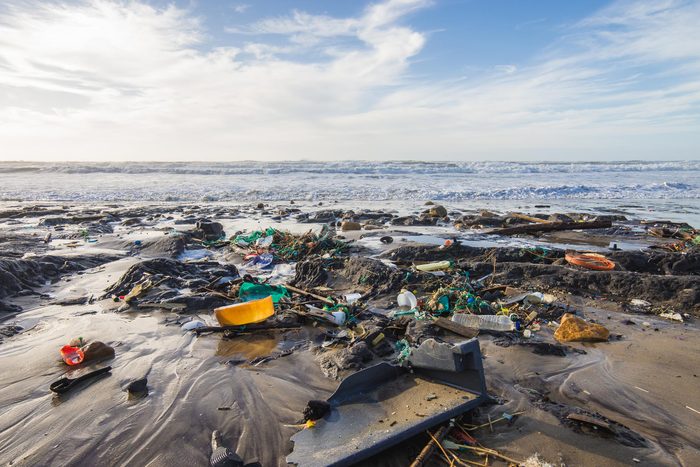
Montalivet, France (now)
Of course, the cleanliness award is ironic when considered in conjunction with this photo of Montalivet in winter—when trash on the beach becomes more prevalent. One possible reason: shifting ocean currents helped along by seasonal storm winds, which can cause the marine debris caught in the vast North Atlantic garbage patch to move by as much as 800 miles north or south.
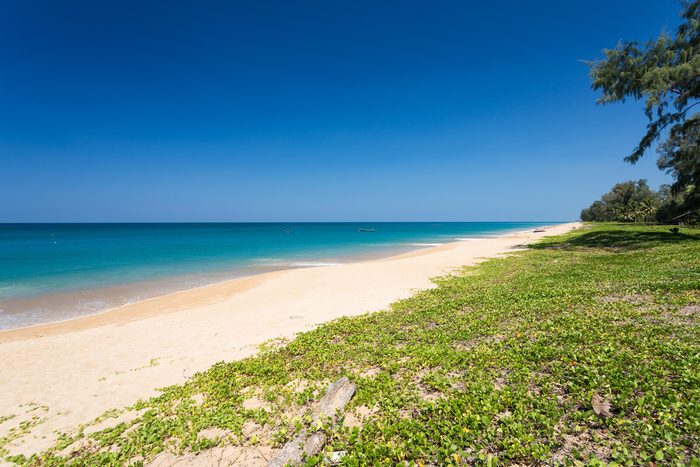
Mai Khao Beach, Phuket, Thailand (then)
Comprised of 7 miles of undeveloped beach in Sirinit National Park, in Northern Phuket, the name of this beach translates to “white wood”—and its sand certainly appears glistening white in promotional photos. The bright blue waters of the Andaman Sea are another hook for scores of international travelers.
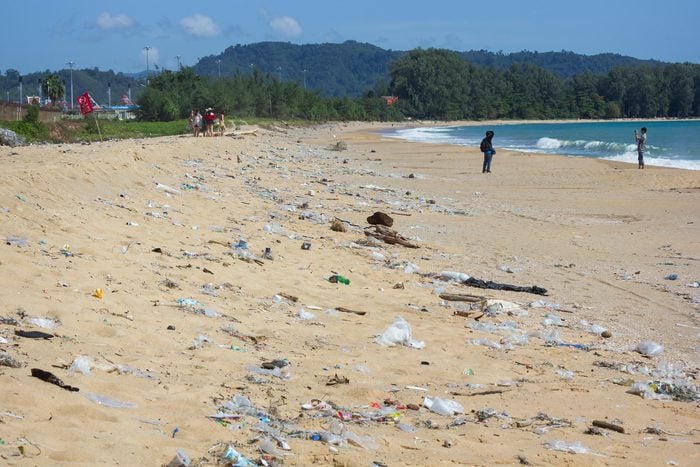
Mai Khao Beach, Phuket, Thailand (now)
The beaches of Phuket, though, are suffering from marine pollution—due, in part, to “inadequate waste disposal systems chucking thousands of tons of raw sewage into the sea,” according to local paper The Thaiger. The article also identifies plastics pollution as a serious threat to the health of the Andaman. It cites studies that point to the Thai fishing industry—which, ironically, suffers acutely from the pollution of its seas—as being “one of the worst local offenders. All the garbage from these boats is simply jettisoned overboard.”
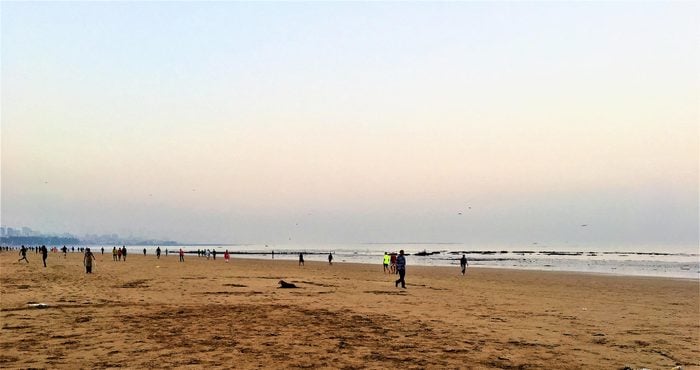
Juhu Beach, Mumbai (then)
One of Mumbai’s most beloved beaches, Juhu attracts garden-variety tourists and celebrity visitors alike, who turn up to watch magnificent sunsets from its warm sands beside the Arabian Sea or, in the morning, to practice yoga while looking out over the quietly lapping tides.
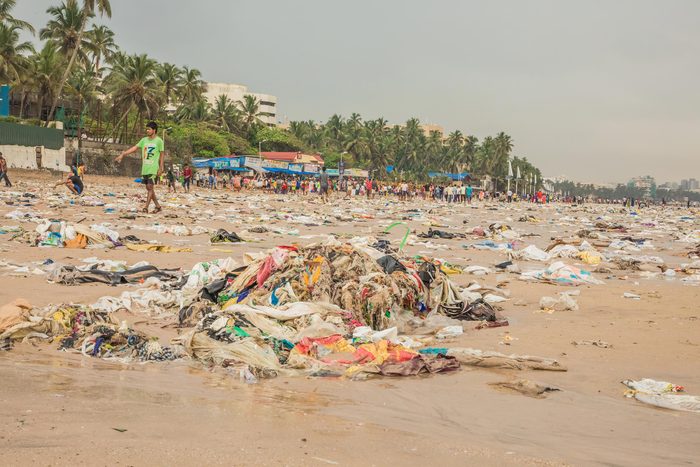
Juhu Beach, Mumbai (now)
The situation at Juhu Beach turns ugly in late May. That’s when what Mongabay calls Mumbai’s “always under capacity” garbage disposal system shows how inefficient it really is, and “[w]ave action and strong winds before monsoon cause trash from ocean to be washed ashore,” says the paper. “The trash primarily includes plastic waste along with other household and personal use items that have been discarded into the city’s drains, rivers and creeks and ended up in the sea.” No amount of cleanup ever seems to be enough; in May of 2018, Hindustan Times reported that the ocean had “coughed up” almost 1,800 pounds of plastic trash onto Juhu’s sands. These 50 facts will convince of the importance of using less plastic.
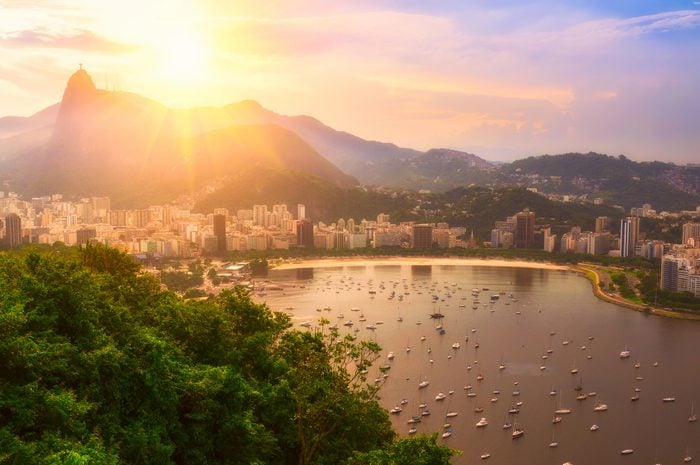
Botafogo Beach, Rio de Janeiro (then)
This gorgeous curve of white sands within Rio’s Guanabara Bay, with Sugarloaf in the background, is one of the most classic and best-known images of Brazil’s capital city—a city worth visiting despite its legendary “tourist trap” status. Frequented by locals playing volleyball or just hanging out, the beach has been a staple of life in Rio since it was first built in the early 20th century.
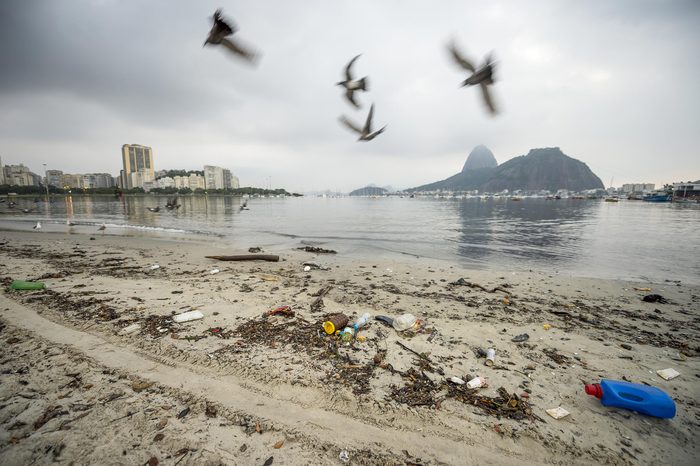
Botafogo Beach, Rio de Janeiro (now)
But the beach has a dirty little secret—that’s actually not so little, and not much of a secret anymore. “[Untreated sewage and industrial waste…pours into the bay on a daily basis,” leading to high numbers of viruses and bacteria. “Broken television sets, plastic bags, and used condoms are a more common sight than fish,” reported Vice Sports on the even of Rio’s hosting of the 2016 Olympic Games. The article cites unchecked and unregulated industrial growth, lackluster cleanup efforts, and environmental disasters like tanker leaks for Botafogo’s woes; seasonal rains also dredge up extra pollution. Despite all this, it’s not one of the 13 most dangerous beaches in the world.
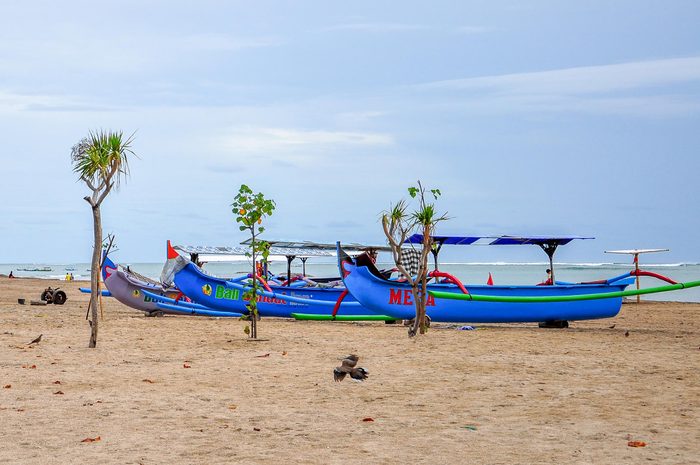
Kuta Beach, Bali, Indonesia (then)
Bali.com credits Kuta with launching the “modern era of tourism in Bali.” The famous golden-sand beach, located on the island’s western coast, was once a fishing village but has grown in popularity as a surfing site, with mellow, consistent waves that break for the full extent of its mile-long stretch.
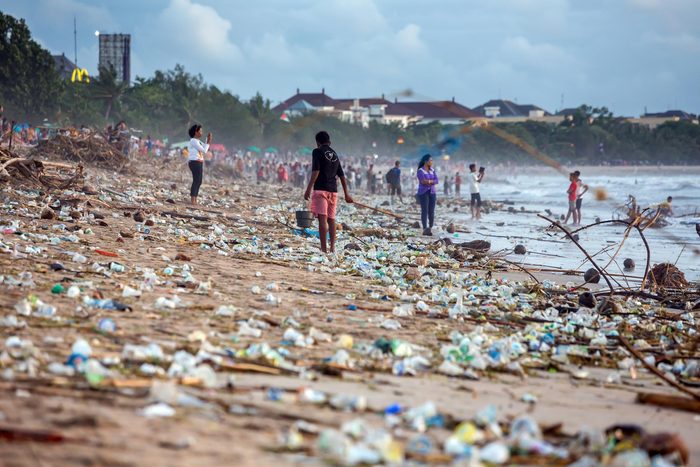
Kuta Beach, Bali, Indonesia (now)
Tragically, though, this beautiful beach has been ranked by Insider as one of the world’s 13 dirtiest. Indonesia, the article points out, is the second-biggest marine polluter in the world (behind China), which has led to its beaches—including Kuta—being covered in trash, “especially during the rainy season” aka, “garbage season.” That’s when vast amounts of trash wash up onto the shore. In 2018, several news outlets ran a video of the annual scourge—to the horror of readers and watchers around the world.
